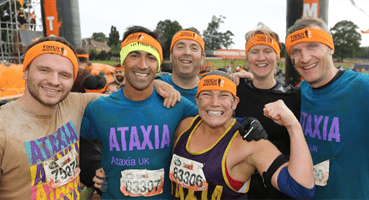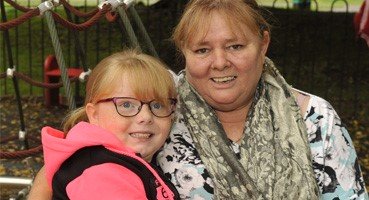In September 2017, Ataxia UK together with GoFar (Italian organisation) and FARA (American organisation) organised the second International Ataxia Research Conference in Pisa, Italy. This is a key event for researchers, clinicians and representatives from pharma/biotech companies who have interest in research on ataxia. This event was larger than the previous one, with more than 400 delegates coming from 22 different counties. A dense programme was spread over four days with 59 presentations and 200 posters presented, as well as two new items for this edition: a roundtable discussion on patient perspective on clinical trials and another roundtable on clinical trial design for ataxias.
The panel of discussion dedicated to patients was certainly one of the highlights of the conference. Attendees included patients and caregivers, five of whom took part in an hour-long roundtable on the challenges of living with an ataxia and what they would most like to see treatments address. The five said that in addition to therapies that address the movement and balance difficulties that are hallmarks of ataxias, they would like to see treatments for the vision, hearing and speech losses that the conditions can generate.
Patient panel and networking session
This conference was marked by a significant growth in research. More than 20 presentations at IARC 2017 focused on treatments, demonstrating the progress scientists are making in expanding the therapy pipeline. This includes testing treatments in cell and animal models as well as in trials involving people. Many research updates were given through plenary sessions, poster presentations, on spinocerebellar ataxias, immune-mediated ataxias, FA and more. You can find more information about this event in the program and a list of abstracts from the speakers at the conference can be viewed here.
Plenary session and poster presentation
The conference was a real success and the feedback received from delegates was excellent. We were particularly thrilled to have Jason Alhuwalia, Friend of Ataxia UK, talented photographer and videographer, who kindly offered his services pro-bono at the conference doing the photography for the event as well as videoing some presentations and running interviews. Ataxia UK is very grateful to Jason for his hard work done at IARC2017 and we have enjoyed having him with us in Pisa to cover the largest research conference on ataxia ever organised. You can fin below the list of videos made at this event.
Plenary sessions
The rapid progress in next generation genetics of ataxia , challenges and next steps
Speaker: Matthis Synofzik, PhD (University of Tuebingen, Germany)
https://www.youtube.com/watch?v=84GR_7FT6Cs&feature=youtu.be
The presence and relevance of autoantibodies to CNS proteins in patients with CA
Speaker: Angela Vincent, Professor (Nuffield Department of Clinical Neurosciences, Oxford, UK)
Research results into epigenetic silencing in Friedreich’s ataxia
Speaker: Sanjay Bidichandani, MBBS, PhD (The University of Oklahoma Health Sciences Center)
Spinocerebellar ataxia type 1 (SCA1): Insights into neurodegeneration in purkinje cells & brainstem
Speaker: Professor Harry Orr, PhD (Institute of Translational Neurosciences, University of Minnesota)
Longitudinal MRS, MRI and DTI of the spinal cord and brain in Friedreich’s Ataxia
Speaker: Pierre-Gilles Henry, PhD (Center for Magnetic Resonance Research, University of Minnesota)
Exercise stress testing on adaptive equipment is feasible and reliable in Friedreich Ataxia
Speaker: Kimberly Lin, MD (Cardiac Center, Children’s Hospital of Philadelphia)
Cardiac Magnetic Resonance T1 Mapping as a Window into the Myocardium in Friedreich Ataxia
Speaker: Kimberly Yee Lin, MD (The Children’s Hospital of Philadelphia)
https://www.youtube.com/watch?v=zht7G1m2GMU
CCFS: a quantitative score of cerebellar dysfunction and evolution in Friedreich ataxia
Speaker: Professor Alessandra Durr, MD, PhD (The Institut du Cerveau et de la Moelle Epinière Pitie-Salpetriere University Hospital, Paris)
https://www.youtube.com/watch?v=i-zR05dTzPA
Poster sessions
Exciting research to increase frataxin in patients with Friedreich’s Ataxia
Poster by Richard Wade-Martins MA DPhil (Professor of Molecular Neuroscience, Oxford University, UK)
HAX-1 is a potential molecular biomarker for cardiomyopathies in Friedreich’s Ataxia
Poster by Fabio Cherubini, PhD (Laboratory of Signal Transduction, University of Rome, Italy)
https://www.youtube.com/watch?v=ZIdVv3GzzIs
Effect of Diazoxide on Friedreich Ataxia Models
Poster by Carlo M T Marobbio, PhD (Department of Biosciences, Biotechnologies and Biopharmacutics, University of Bary)
https://www.youtube.com/watch?v=sDUyGlLmHn4
Stimulating neural repair through bone marrow stem cell fusion in models of FA
Poster by Kevin Kemp, PhD (Clinical neurosciences, University of Bristol)
https://www.youtube.com/watch?v=bvAim7sPkt4
Interviews
Preclinical tools to advance FA clinical trials
Julie Vallortigara PhD (Research Officer, Ataxia UK) Talks to IARC 2017 Speaker: Vijay Chandran, PhD Assistant Professor (Department of Pediatrics, University of Florida, US)
Identification of a new SCA gene in Cerebellar Ataxia
Interview: Prof Dineke Verbeek (University of Groningen, Netherlands)
Interview: Andreia Alexandra Neves Carvalho, PhD (University of Minho, Portugal)
The presence and relevance of autoantibodies to CNS proteins in patients with CA
Interview: Angela Vincent, Professor (Nuffield Department of Clinical Neurosciences, Oxford, UK)
https://www.youtube.com/watch?v=uDU5YqXVPx0
Omaveloxone (RTA 408) Trial for patients with FA
Interview: Colin Meyer, Dr (Reata Pharmaceuticals)
https://www.youtube.com/watch?v=oR7UlJwbdhE
Some feedback from delegates
“I thought it was a very well organized event. I enjoyed every part very much.”
“It was nice to have the opportunity to meet people.”
“The conference was very well planned and balanced between time to network and the time devoted to presentations.
“It was a good idea not to have separate sessions for the various ataxias but to mix this among the different sessions.”
“I thought this conference was well balanced. I liked the progression of talks from basic science through clinical research. It was very well planned.”
Many thanks to the Scientific Steering Committee:
Vijay Chandran
Paola Giunti
Julie Greenfield
Barry Hunt
Jane Larkindale – Co-Chair
Patrícia Maciel
Giovanni Manfredi
Nick Muzyczka
Marek Napierala
Massimo Pandolfo
Len Petrucelli
Bernardo Ruggeri
James Rusche – Co-Chair
Matthis Synofszik










